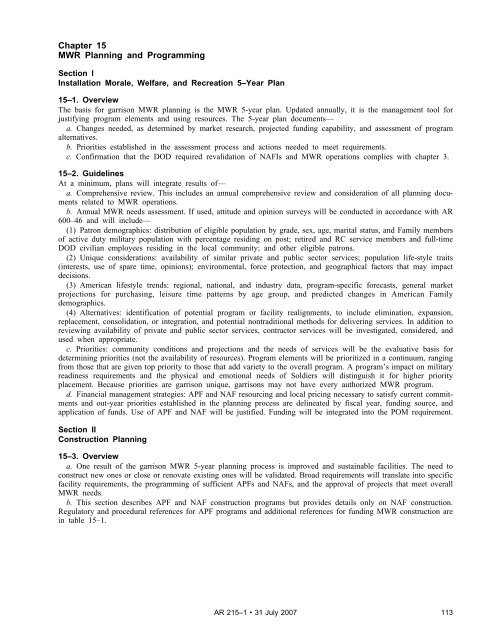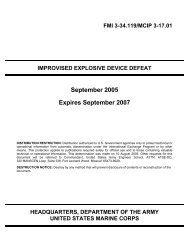AR 215-1 - Soldier Support Institute - U.S. Army
AR 215-1 - Soldier Support Institute - U.S. Army
AR 215-1 - Soldier Support Institute - U.S. Army
Create successful ePaper yourself
Turn your PDF publications into a flip-book with our unique Google optimized e-Paper software.
Chapter 15<br />
MWR Planning and Programming<br />
Section I<br />
Installation Morale, Welfare, and Recreation 5–Year Plan<br />
15–1. Overview<br />
The basis for garrison MWR planning is the MWR 5-year plan. Updated annually, it is the management tool for<br />
justifying program elements and using resources. The 5-year plan documents—<br />
a. Changes needed, as determined by market research, projected funding capability, and assessment of program<br />
alternatives.<br />
b. Priorities established in the assessment process and actions needed to meet requirements.<br />
c. Confirmation that the DOD required revalidation of NAFIs and MWR operations complies with chapter 3.<br />
15–2. Guidelines<br />
At a minimum, plans will integrate results of—<br />
a. Comprehensive review. This includes an annual comprehensive review and consideration of all planning documents<br />
related to MWR operations.<br />
b. Annual MWR needs assessment. If used, attitude and opinion surveys will be conducted in accordance with <strong>AR</strong><br />
600–46 and will include—<br />
(1) Patron demographics: distribution of eligible population by grade, sex, age, marital status, and Family members<br />
of active duty military population with percentage residing on post; retired and RC service members and full-time<br />
DOD civilian employees residing in the local community; and other eligible patrons.<br />
(2) Unique considerations: availability of similar private and public sector services; population life-style traits<br />
(interests, use of spare time, opinions); environmental, force protection, and geographical factors that may impact<br />
decisions.<br />
(3) American lifestyle trends: regional, national, and industry data, program-specific forecasts, general market<br />
p r o j e c t i o n s f o r p u r c h a s i n g , l e i s u r e t i m e p a t t e r n s b y a g e g r o u p , a n d p r e d i c t e d c h a n g e s i n A m e r i c a n F a m i l y<br />
demographics.<br />
(4) Alternatives: identification of potential program or facility realignments, to include elimination, expansion,<br />
replacement, consolidation, or integration, and potential nontraditional methods for delivering services. In addition to<br />
reviewing availability of private and public sector services, contractor services will be investigated, considered, and<br />
used when appropriate.<br />
c. Priorities: community conditions and projections and the needs of services will be the evaluative basis for<br />
determining priorities (not the availability of resources). Program elements will be prioritized in a continuum, ranging<br />
from those that are given top priority to those that add variety to the overall program. A program’s impact on military<br />
readiness requirements and the physical and emotional needs of <strong>Soldier</strong>s will distinguish it for higher priority<br />
placement. Because priorities are garrison unique, garrisons may not have every authorized MWR program.<br />
d. Financial management strategies: APF and NAF resourcing and local pricing necessary to satisfy current commitments<br />
and out-year priorities established in the planning process are delineated by fiscal year, funding source, and<br />
application of funds. Use of APF and NAF will be justified. Funding will be integrated into the POM requirement.<br />
Section II<br />
Construction Planning<br />
15–3. Overview<br />
a. One result of the garrison MWR 5-year planning process is improved and sustainable facilities. The need to<br />
construct new ones or close or renovate existing ones will be validated. Broad requirements will translate into specific<br />
facility requirements, the programming of sufficient APFs and NAFs, and the approval of projects that meet overall<br />
MWR needs.<br />
b. This section describes APF and NAF construction programs but provides details only on NAF construction.<br />
Regulatory and procedural references for APF programs and additional references for funding MWR construction are<br />
in table 15–1.<br />
<strong>AR</strong> <strong>215</strong>–1 • 31 July 2007<br />
113

















